#can clematis grow in shade
Explore tagged Tumblr posts
Text
#grow clematis#how to propagate clematis#exotic plants online#rose diseases and pests#how to grow clematis#country rose#buy clematis#rose diseases#plants online#exotic plants#where to buy clematis#propagate clematis#how to propagate#clematis grow in shade#super fine#long serve#clematis cutting#clematis grow#can clematis grow in shade#clematis cultivars#cutting plant#tip cuttings#tip cutting#transplanting clematis#new clematis#should be long#transplanting clematis plants#propagating clematis cuttings#new clematis plants#fresh green
0 notes
Text
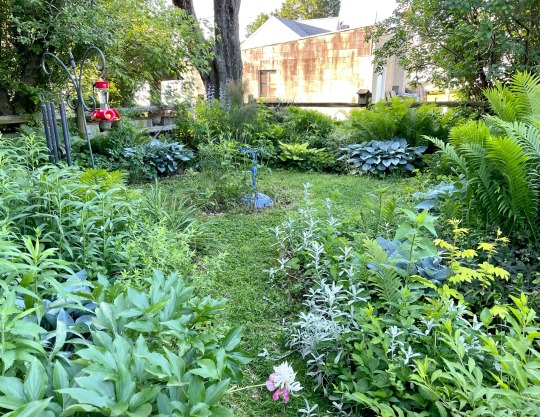
A conversational post. Last year I had an injury and couldn’t keep up with the garden much to the delight of many species of plants, insects and birds. This year I’ve been doing some cleanup and as I cut away ferns and goldenrod and other plants that have taken advantage of neglect moths and other insects are sadly fluttering up out of their hiding places reminding me that all lawn and garden cleanup is habitat loss.
Sometimes cleanup has to be done for social reasons like neighbors (the area between my garden fence and the neighbors’ fence is full of ostrich ferns but among them are some nettles. Probably if I don’t cut them the neighbors will but if they don’t know what nettles are and grab them gloveless to cut them they’re in for a world of pain. Better I glove up and handle them myself.) My neighbors’ kids play in their lawn and sometimes balls or frisbees land between the fences so they prefer it not to be a jungle or nature preserve in there. Ticks are a real threat here and I don’t want kids to get them because of me.
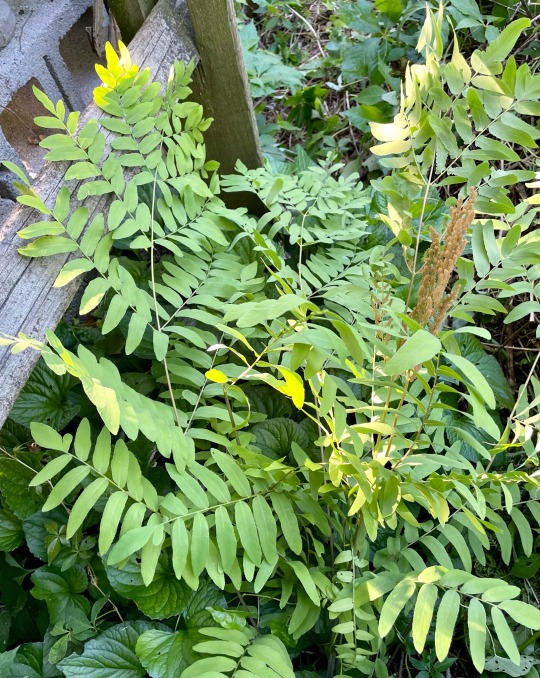
I’ve also been wading through the mess/habitat eliminating vines. I’ve pulled a lot of bindweed and clematis paniculata down from the lilac. I have to do that all summer or they overwhelm it. Vines are like parasites, using other plants to give them a leg up and then shading those plants with their leaves. Virginia creeper has to be kept down to a dull roar too. Today I found that one of my most beloved native plants, the royal fern, Osmunda regalis, above, was plagued with bindweed. It has enough trouble surviving in this non-woodland environment without vines pulling its fronds down out of the sunlight. I removed each vine gently and am hoping for the best.
But every single thing like this disturbs things, robs living things of habitat, reduces the amount of food that wrens and other birds can find for their growing families, so I try to be thoughtful and try to leave some areas as undisturbed as I can without allowing plants that will do more harm than good to take over. The whole garden grows better if some of it is left wild for insects and other creatures to use.
tl;dr: All yard trimming and cleanup is habitat destruction but sometimes you have to do it. Just be thoughtful and leave room somewhere for nature to do its thing. (If calling it “leaving room for the fairies to live in” makes it more fun, do that. Because after all, who knows?)
#pennsylvania#garden#gardening#long post#gardening thoughts#osmunda regalis#habitat destruction#garden cleanup
227 notes
·
View notes
Photo



Clematis
On the importance of H2O
I love the clematis flower, especially the cultivar “Nelly Moser” shown in the third photograph. We used to have Nelly Moser climbing in our privet hedge but alas, after a few years, it succumbed. I confess, that was my fault. The clematis likes shade on its roots, so planting it underneath a privet hedge was a good idea but in hindsight, I think our well-rooted privet simply sucked up all the wet stuff. In gardening, you live and you learn. If I ever grow a clematis again, next time I’ll be a little more attentive with the watering can.
#flowers#photographers on tumblr#clematis#gardening#Nelly Moser#fleurs#flores#fiori#blumen#bloemen#vancouver
184 notes
·
View notes
Text
The language of flowers
Wei Wuxian loves gifting his husband flowers - but they're never randomly chosen. His bouquets have meanings, always - because the only item he has left from his mother is a book on the language of flowers. She used to tell him flowers aren't just pleasing to the eyes, they can also whisper to the heart. And as with the sparse memories he has of her, Wei Wuxian has kept these words close to his heart.
On his first date with Lan Wangji, he brought him a bouquet of blue hydrangeas. Gratitude, grace and beauty. He had attached a little note to it, explaining the meanings of the flowers and how they reminded Wei Wuxian of Lan Wangji's elegance and beauty, and how he had been grateful that Lan Wangji had asked him out on a date. He also added some advice on how to care for the flowers, and a lipstick stain kiss in the corner of the card, just to be cheeky.
On their one year anniversary, he brought Lan Wangji a bouquet of blue clematis flowers. The base petals shone a pretty, silvery white, and they layered upwards into shades of blue. Loyalty, courage, mental strength. It had not been an easy year, with their families disapproving of their relationship, the backlash of it, scandals after scandals. But they stayed true to one another and their love regardless.
They had two flower bouquets at their wedding. Both gentians. Justice and victory, prevailing through hardship. And a symbol for Lan Wangji's late mother, who would grow gentians in little flower pots and call them her windowsill garden.
When A-Yuan's adoption papers came in, both Wei Wuxian and Lan Wangji made him a beautiful bouquet - sunflowers, gerberas, marigolds and daisies. Joy, happiness, optimism. He had kept telling them how much he loved flowers and how he wished to visit a field of colorful ones like he read in his story books. So they brought a patch of flower field to him when they picked him up, and stopped to laugh and chase one another in a lavender field on the way home.
Wei Wuxian wanted to open up a flower shop. Lan Wangji gifted him the key to his dream job into the petals of a red rose.
---
Lillies are fragrant, large flowers, white, pink or orange. Innocence, peace, beauty.
Orchids mean "I will always love you", everlasting devotion to the very end.
Gladioli symbolize strength of character, integrity, faithfulness.
Lan Wangji picks up two of each, and ties them separately with red and white ribbons.
They're beautiful, fresh, colorful.
He lays them onto Wei Ying's grave with A-Yuan.
"Do you think baba would like them?"
"Mn."
A-Yuan smiles, tearful, looking at the small oval picture of his baba on the tombstone. "I hope the flowers whisper something nice to him today."
Lan Wangji can't find it in himself to speak, the knot in his throat is too tight.
#mdzs#mo dao zu shi#wangxian#writing attempts#this is the prompt my friend asked for and now that i did it shes yelling at me for making her cry
97 notes
·
View notes
Text
What does your kinky garden look like?
No seriously. What does it look like? You should always be striving to cultivate trust between you and your partner in a bdsm dynamic and I say that to ask: have you checked on your kinky garden lately? What does your kinky garden look like?
Plant your kinky seeds with intention and structure your garden how you want it to best fit your needs.
Where does the spanking tree go? Does it go front and center where it's easily accessible or do you need it in the back to help shade and give your domestic discipline clematis something to climb on so it can thrive? Do you even need a spanking tree or do you just feel pressure to have one?
Develop your garden and make sure it's getting plenty of sunlight and water and attention. The edging around the orgasm control bush may need more careful tending to in order to keep it healthy because your partner gets so sensitive to touch.
Meanwhile the obedience peonies seem to do fine all on their own because your partner loves being obedient so they don't need as much reinforcement, but still need nurturing.
Maybe you found it more enjoyable and less intense for you to have cat-tail mouth gags at the water's edge rather than latex hood lilypads in your garden's pond.
Maybe your kinky garden is a zen garden because you're asexual. You keep around plenty of bondage bonsai's and masochism hedges, but you don't need any blowjob bluebells or intercourse irises in your kinky garden like most of your neighbors do.
Also did you make sure to use the praise mulch on your degradation daisies like your partner asked? They won't grow without it they said!
Maybe you'll have an unforeseen allergic reaction to the hotwife heather you planted and you can't keep that plant around, but that's okay, that's why we keep a hard limit compost pile near the soft limit locked shed. What's important is you tried and found it didn't work for you.
Maintain your garden and when the ears of butt plug corn aren't looking healthy, ask questions, be supportive, and do your research and plant waxplay soybeans instead to rotate with the corn. So you have variety
And remember that sometimes you may need to leave patches of your garden alone to let the soil get healthy and fill with nutrients again so that your kink garden can thrive and plants can be added.
How your kinky garden is cultivated matters.
To cultivate means to "to make an effort to establish, develop, and maintain a relationship." You can have whatever rules you decide on in your power dynamic and kinky fun, but just make sure you cultivate your relationship like you would a garden.
Trust is vital and connection is everything. Cultivate your kinky relationship like a garden and it will flourish, but flourishing never occurs without effort.
What does your kinky garden look like?
5 notes
·
View notes
Text
Hm.

I can confidently identify daffodils, marigolds (currently feeling smug for calling that one months ago,) and a gerbera daisy.
I'm pretty sure the purplish flowers on the bottom center are Rugosa, but they might also be poppy or anemone. Will try to narrow it down later.
I saw someone on twitter say the flowers on the bottom left are probably primrose. They look similar, but the one reservation I have is that the flowers aren't growing in the typical clustered bunches.
I'm having trouble with the vine(?) at the top of the image. The flowers are shaped somewhat like azaleas, but those grow in clusters on shrubs and trees, not at the ends of spindly, herbaceous stems--and I don't think they come in that shade of purple either. Lobelia sessilifolia? Clematis? Nothing I'm coming up with looks quite right...
11 notes
·
View notes
Text
Oops
Soooo, I’ve been making a lot of noise about getting our back porch stained. It’s just bare wood, and my decades in the deep south make me itchy to protect it from weather, bugs, rot, etc. Maybe it’s different up here but I doubt it. Anyway, we were in Easton a couple of days ago so I popped into Lowe’s and bought stain. Our house is gray, the shutters are sort of a deep charcoal, the front porch and all the window trim is white. In Nancy Land that means that you don’t buy any of the hundred shades of brown stain - tones from light oak to mahogany or a deep walnut. Nope, I looked at the semi-transparent grays. I didn’t want to match the gray of the house, I knew that I needed to compliment it with a deeper tone. I should add, that I wanted to just paint it white to match the front porch. The mister was adamant that white was not a good idea. I agreed that white wouldn’t last on the floor boards, but everything else would work. He stood his ground. I figured if I was going to give him his way with a color choice that something attached to the back of the house was my best bet. So I picked a color called Dutch Licorice. I chose a semi-transparent base for the color because the sample piece of wood at the store in that color and base was just right. Not too light, not too dark, the woodgrain showed through the wash of color - perfect. Except it’s not. You guys....I snapped this photo when I was about halfway finished.
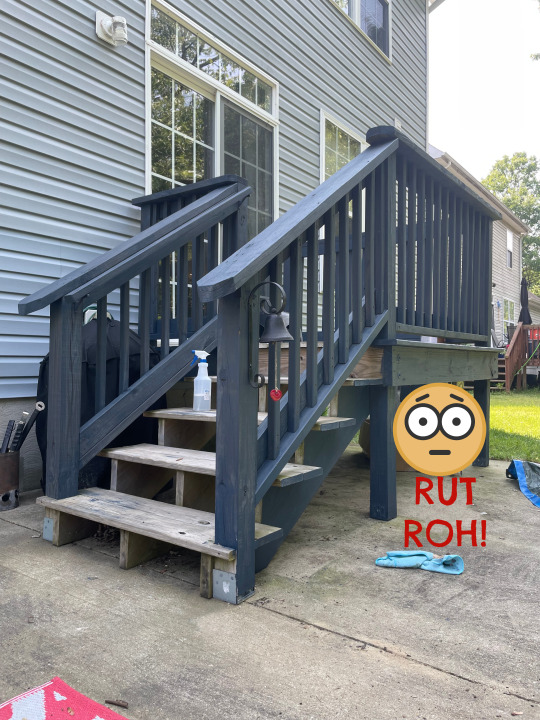
Yes, I know the patio looks absolutely awful. It’s begging to be power washed. I’ll get to it. But look at that stain! Yikes! I told my sister that it looks like Darth Vader is sitting right in the middle of my carefully curated, blossom covered, white picket fenced, birdie sanctuary. Rats. Because I am cheap, I used what I bought. Lowe’s won’t let me return a can of regret. I’ll admit, it’s finished now and looks almost okay in sunlight. I’m going to have to brighten it up with white pots of colorful flowers. I’ll provide more pics when it gets to that point. I can count on one hand the times in my life when I’ve regretted a color choice (we’re not talking about my hair) but this one goes on the list. I’m glad it’s on the back of the house, but I still think the squirrels are judging it.
In other news, my itty-bitty vinca are trying really hard to show off. I’ve been so concerned about them because they haven’t seemed too robust, but they’re trying. Hopefully they’ll fill in, flower abundantly, and that row of little flowers will become a tumble of red.
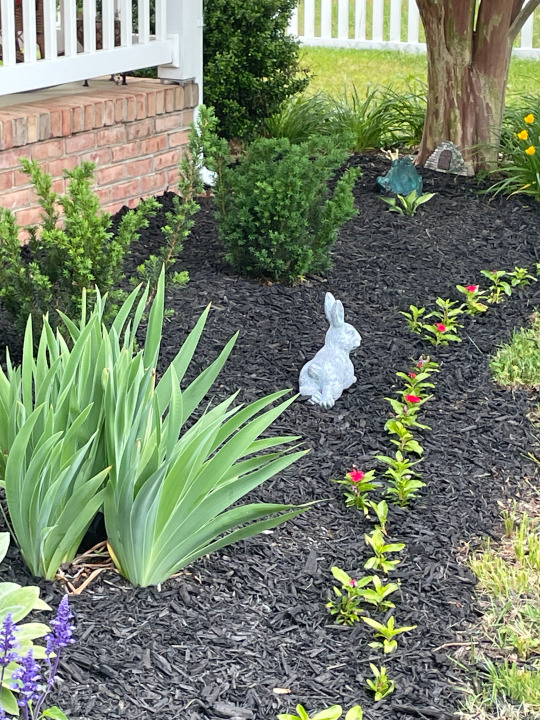
Vinca was an easy, reliable work horse in my gardens in Mt. Juliet. Maybe they don’t like it here. I’ve dropped sunflower seeds along the porch and they’re doing great. I can’t remember the name, but they should be about four feet tall which would be perfect for this bed.
This little clematis is thriving, and I’ve provided some twine for it to climb toward the porch. Grow, little girl, grow!
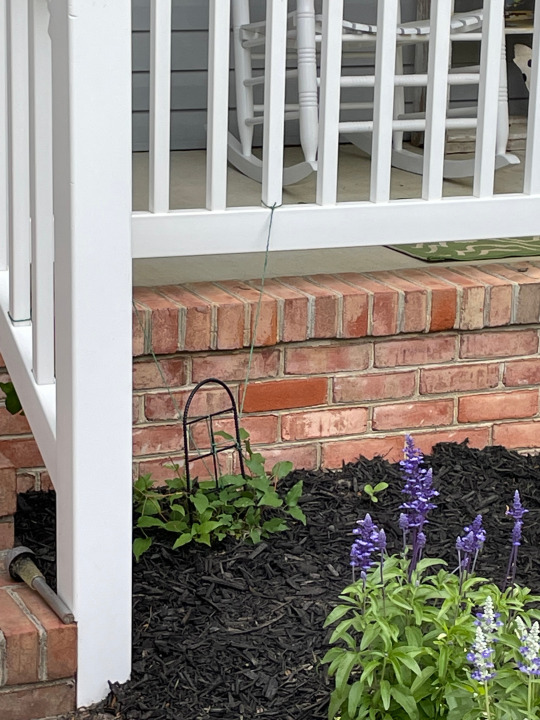
I rescued this baby from the orphan table for $2.00. I think she’ll make it. She probably won’t stay there, that’s just her ICU. She might end up potted with some friends. We’ll see.

This fern loves its spot by the front door.

It’s early days, but I have high hopes for this spot.

I’ll add more, but it’s coming along.
Have I made you forget about that travesty of a back porch yet? I tried not to think about it as I sat at my desk today and played with some paper and paint. This sweet kitty kept me company.

“Animals are such agreeable friends. They ask no questions, they pass no criticisms.” - George Eliot She told me that she didn’t care one little bit about the color of that porch. Then I remembered that cats see basically in blue and gray and realized that she doesn’t appreciate anything I do around this house. All that matters to her is the can opener. Still, I appreciated the support.
Tomorrow the mister wants to run off to D.C. He’s got an urge to go to the Air & Space Museum and I figure I can at least get lunch out of it. Since I’ve spent the last few days spreading mulch, scrubbing and staining that porch, and hauling and cooking groceries - I need a nice lunch in a nice place. That’s it for me tonight. I’m off to soak my aching bones and then read myself to sleep. More tomorrow, hopefully something fun from D.C. ,certainly more exciting than mulch and stain. Sending out loads of love, wishing you peace and contentment, and hoping that you stay safe and stay well. XOXO - Nancy
5 notes
·
View notes
Text
Landscaping Ideas to Enhance Your Keystone Wall: Tips and Inspiration
A keystone wall is a practical and aesthetically pleasing addition to any landscape. These walls not only serve structural purposes, such as soil retention and erosion control, but they also offer a canvas for creative landscaping. Whether you're looking to boost your curb appeal or create an inviting outdoor space, effective landscaping can significantly enhance the visual impact of your keystone wall construction. In this blog, we will explore various landscaping ideas to inspire your next outdoor project.
1. Select Complementary Plantings
One of the most straightforward ways to enhance your keystone wall is by choosing the right plants. Consider selecting low-maintenance perennials and shrubs that complement the stone's color and texture. Native plants are a great option as they typically thrive in local climates and require less watering and care.
Planting flowering perennials at the base of the wall can create a vibrant border. Think of species that bloom at different times of the year to ensure visual interest throughout the seasons. Additionally, ornamental grasses can add texture and movement, especially when swaying in the wind.
2. Add Vertical Elements
Vertical landscaping elements can draw the eye upward and create a sense of depth. Climbing plants, such as ivy or clematis, can be trained to grow up trellises or along the wall itself, softening the hard lines of the keystone structure. This not only adds greenery but also introduces a lively, dynamic aspect to the landscape.
Incorporating trellises or arbors in front of your wall can create a stunning focal point. These structures can be adorned with flowering vines, adding layers of color and texture while providing additional shade in your outdoor space.
3. Create a Rock Garden
A rock garden can beautifully complement a keystone wall construction, utilizing similar materials and enhancing the overall aesthetic. This type of garden can incorporate various stones, boulders, and gravel, which can echo the stone of the wall itself.
Intersperse drought-resistant plants like succulents or alpine flowers among the rocks to create a natural look. This not only requires minimal maintenance but also allows for a unique visual texture that contrasts with the vertical lines of the wall.
4. Incorporate Hardscaping Features
Hardscaping elements, such as pathways, patios, or retaining steps, can further enhance the area surrounding your keystone wall. These features can provide functional space while harmonizing with the wall's design.
Consider using the same type of stone or color palette for these elements as the wall to create a cohesive look. Paver stones can be used to create a stylish walkway leading to the wall, inviting guests to explore your outdoor space.
5. Add Lighting
Incorporating lighting into your landscape design can dramatically change the atmosphere of your keystone wall at night. Strategically placed landscape lights can highlight the wall’s texture and create an inviting ambiance.
Consider using up-lighting to cast shadows and emphasize the wall's height or down-lighting for a softer glow. Solar-powered lights are an eco-friendly option that can add functionality while being easy to install.
6. Introduce Water Features
Water features, such as fountains or small ponds, can create a serene atmosphere and enhance the overall appeal of your outdoor space. The sound of flowing water can provide a relaxing backdrop and attract wildlife, adding to the natural beauty of your landscaping.
Position a water feature near your keystone wall to create a focal point. The wall's reflection in the water can add depth and interest to the landscape.
Conclusion
Enhancing your keystone wall with thoughtful landscaping can transform your outdoor space into a stunning retreat. By selecting complementary plantings, incorporating vertical elements, creating a rock garden, and introducing hardscaping and lighting, you can elevate the aesthetic appeal of your keystone wall construction. With these tips and inspiration, you can create a harmonious landscape that showcases your style while enjoying the functional benefits of your wall. Embrace your creativity and let your outdoor space flourish!
0 notes
Text
Best Plants for Outdoor Gardens: Transform Your Backyard into a Green Oasis
Creating a vibrant outdoor garden requires selecting the right plants that can thrive in your specific climate and garden conditions. Whether you have a sprawling backyard or a compact space, choosing the right plants can enhance the beauty and functionality of your garden. Here’s a guide to some of the best plants for an outdoor garden that are not only easy to care for but also add color, texture, and structure to your outdoor space.
1. Perennials: Long-Lasting Beauty
Perennials are plants that come back year after year, making them ideal for gardeners who want a low-maintenance yet beautiful garden. Some popular perennials for outdoor gardens include:
Lavender (Lavandula): Known for its fragrant blooms and silvery-green foliage, lavender thrives in full sun and well-drained soil. It's also drought-tolerant and attracts pollinators like bees and butterflies.
Coneflower (Echinacea): A hardy plant with vibrant purple, pink, and white petals, coneflowers are drought-tolerant and low-maintenance. They are also great for attracting bees and butterflies.
Hostas: Ideal for shady areas, hostas offer lush green or variegated leaves, adding texture and depth to garden beds.
2. Annuals: Burst of Seasonal Color
Annual plants complete their life cycle in one season, but they provide a spectacular burst of color that can rejuvenate your garden every year.
Marigolds (Tagetes): These bright, cheerful flowers are easy to grow and come in a range of warm colors like yellow, orange, and red. They thrive in sunny spots and are great for deterring pests.
Petunias: Known for their trumpet-shaped blooms, petunias come in a wide variety of colors and patterns. They are great for garden beds, hanging baskets, and containers.
Zinnias: Zinnias are easy to grow, drought-resistant, and come in bright colors that attract pollinators. They bloom from summer to fall, adding continuous color to your garden.
3. Shrubs: Structural Elements
Shrubs add structure and depth to your garden, providing year-round interest and making them great for border planting or as focal points.
Boxwood (Buxus): A classic choice for hedges, boxwood is an evergreen shrub that can be shaped and maintained in various forms. It’s perfect for creating garden borders or topiaries.
Hydrangea: With large, showy flowers, hydrangeas are a favorite for their stunning blooms that can vary in color depending on the soil’s pH level. They do best in part-shade with moist, well-drained soil.
Butterfly Bush (Buddleja): As its name suggests, the butterfly bush attracts pollinators like butterflies and bees. It produces fragrant, spiky flowers in shades of purple, pink, and white.
4. Climbing Plants: Vertical Interest
Climbers are perfect for adding height and vertical interest to your garden, whether it’s on a trellis, fence, or pergola.
Clematis: Known for their large, colorful blooms, clematis are perfect for training on trellises or garden walls. They come in various colors and can bloom throughout spring and summer.
Jasmine: With fragrant white or yellow flowers, jasmine is ideal for climbing up structures and adding a sweet scent to your garden.
Wisteria: This vigorous climber is known for its cascading purple or white flowers. It requires a sturdy support structure but rewards you with beautiful, fragrant blooms in spring.
5. Succulents: Low-Maintenance and Hardy
Succulents are a great choice for gardeners looking for low-maintenance plants that can withstand dry conditions. These plants are known for their fleshy, water-retaining leaves.
Sedum (Stonecrop): With its drought-tolerant nature, sedum is perfect for rock gardens or dry areas. It comes in both ground cover and taller varieties, producing clusters of star-shaped flowers.
Aloe Vera: Not only is aloe vera a beautiful plant with spiky leaves, but it also has medicinal properties. It thrives in dry, sunny conditions and can be grown in the ground or containers.
Echeveria: These rosette-shaped succulents are popular for their striking form and variety of colors. Echeveria is perfect for rock gardens, containers, or as ground cover.
6. Ornamental Grasses: Texture and Movement
Ornamental grasses add texture, movement, and a sense of softness to your garden. They are low-maintenance and can thrive in various conditions.
Fountain Grass (Pennisetum): This grass forms graceful, arching clumps and produces feathery flower spikes in late summer. It’s great for adding texture and contrast to flower beds.
Blue Fescue (Festuca glauca): With its blue-gray foliage, blue fescue is a compact grass that works well in rock gardens or as a border plant. It’s drought-tolerant and low-maintenance.
Maiden Grass (Miscanthus): This tall grass features elegant, feathery plumes that sway in the breeze, adding movement to your garden. It thrives in full sun and well-drained soil.
Final Tips for Planting an Outdoor Garden
Consider your climate: Always select plants that are suited to your local climate and soil conditions. Native plants are often the best choice for low-maintenance gardening.
Plan for sunlight: Observe how much sunlight your garden receives throughout the day and choose plants that thrive in those conditions, whether full sun, partial shade, or full shade.
Mix and match: Combine a variety of plants—perennials, annuals, shrubs, and grasses��for a garden that provides year-round interest and color.
Maintain soil health: Ensure your garden has well-drained, nutrient-rich soil. Consider adding compost or organic matter to improve soil quality.
By selecting a mix of plants that suit your climate, garden space, and maintenance preferences, you can create a flourishing outdoor garden that will bring joy and beauty to your home for years to come.
For More Info:-
Plants For Outdoor Garden
Buy Red Robin Tree Ireland
0 notes
Text
Beat the Summer Heat with WPC Pergola Shades
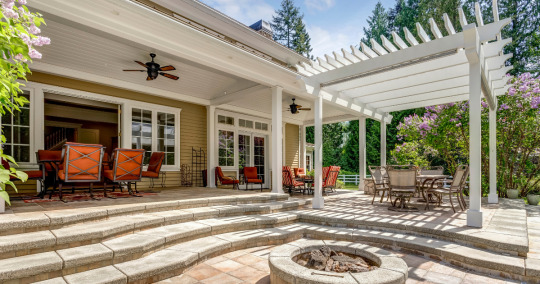
Summer is upon us, and it is time to think of ways and means to protect ourselves from the sun while still enjoying outdoor life. Installing a gazebo on the terrace or a pergola in the garden will provide shade and add class and style to your outdoor space.
WPC Pergolas
Pergolas help minimize the amount of sunlight and heat entering your patio, terrace, or backyard. WPC, or wood–plastic composite, is an ideal material for the construction of pergolas because it is weather-resistant, lightweight, and strong, and requires minimal maintenance compared to natural wood. WPC pergolas are cost-effective and last several years. They bring a modern touch to the natural beauty of wood, adding elegance and sophistication to your outdoor space.
WPC Pergola Design for Home
Several innovative options are available in WPC pergola design for homes. A WPC pergola can be converted into a cozy and pleasant retreat by making simple but striking additions to the basic structure.
Retractable Canopy
Using a retractable canopy over your WPC pergola enables you to adjust the amount of shade based on your preference. You can retract it entirely to bask in the sun or extend it to create a pleasant, cool, and shaded area. These canopies come in different materials such as fabric, metal, and wood, offering flexibility in style and functionality.
Vines and Greenery
Planting vines on your pergola is a great way to create natural shade. Although they may take some time to grow, they can eventually provide a dense canopy of shade and a beautiful, lush atmosphere. Some popular choices for pergola vines include Wisteria, Grapevines, Clematis, and Honeysuckle.
Fabric Shades
Outdoor curtains are a great way to add privacy and shade to your pergola. You can control the light and shade inside the pergola by keeping the curtains partially or fully drawn. The choice of curtain materials is vast, including polyester, acrylic, and canvas. You can match the color, texture, and design of the fabric with the existing style of your exterior.
Bamboo or Reed Mats
A pergola with a roof made of bamboo or reed mats can create a native and earthy feel. The cooling effect achieved is exceptional. The play of light through these materials creates an interesting light and shadow effect, making the pergola a very welcome place for relaxation.
Slatted Pergola Roof Panels and Louvers
A pergola with roof panels is an excellent way to create a cozy outdoor living space. The slats allow sunlight to filter through while still providing shade, making it the perfect spot to relax during the day. Incorporating adjustable louvers on the WPC pergola with the roof can also play a similar role in controlling the sunlight and airflow.
Combination of Elements
Unleash your creative side by exploring various shade options for your outdoor space. While a retractable canopy boasts vine-covered sections that provide a touch of visual interest, adding bamboo mats creates a textured and layered look while providing the necessary shade.
When designing your garden or terrace pergola designs, consider factors like climate, the desired level of shade, maintenance requirements, and overall aesthetic preferences.
Everwood WPC pergolas
Everwood, the leading WPC brand, provides WPC pergola sections that are durable, high-strength, and lightweight. Everwood sections have lesser thermal expansion than natural wood and a higher capacity to handle high temperatures. Pergolas and gazebos created with the reinforced WPC pergola profiles from Everwood can handle mild structural loads well to create beautiful outdoor spaces or building extensions. Everwood WPC pergolas and gazebos are easy to install and easier to maintain. They retain their good looks for years to come.
Source Link: https://everwoodwpc.com/beat-the-summer-heat-with-wpc-pergola-shades/
#wpc#wpccladding#wpcdecking#wpcflooring#wpcpergolas#wpc decking wpc planks wpc tiles#wpc pergolas wpc gazebos wpc elevation
0 notes
Text
40. What simple pleasures of life do you truly enjoy?
One of the greatest pleasures in life that I enjoyed for many years was travelling. Now, at my advanced age I am too old, decrepit and compromised to be so adventuresome. Changing planes in foreign airports terrifies me now. Dealing with foreign currency was made easier with the advent of the euro but still challenging. Making myself understood with little command of the language spoken gave me moments of anxiety if not exasperation. These days I have no such concerns. My simple pleasure requires none of the aforementioned risks and is a pleasure I have enjoyed for many years and continue to enjoy.
I love gardening. My home on Mountain Road has many trees and therefore much shade. Gardening is a challenge. My garden is confined to flowers. there is inadequate sun for growing vegetables. I can garden for hours on my knees without worrying about falling due to my Parkinson’s.
I bought the house on a cold January day. A significant part of the yard was unkempt. The previous owners said they used this section as a duping place for their used Christmas trees. The weeds and grass were adequate to hide most of the mess. Many trees in this area were dead and Peter took them all down for me. He cut them into twelve to fourteen inch pieces and with them I built a wall that separates the back lawn from the wooded area of the lot. I bought a leaf shredder and began to attack the years of accumulated leaves, weeds and branches.
I have flower beds that separate the lawn from the treed area at the back and side of the lot. The one thing I grow very successfully is moss but it is green and serves its purpose,
I have an eclectic garden where i remember friends and family. I have Rose of Sharon shrubs that came from Heather’s house on Carter Street. They are prolific seeders and I have started shrubs for my neighbors and my granddaughter, Anne. My wonderful neighbor, MaryJane gave me an aubergine clematis when my brother Carl died. It is beautiful and climbs a trellis in front of the sun porch. I brought two trellises with me from the Warner house and they are now covered with pink rambling roses given to me by a friend from the East Concord Garden Club to which I had belonged. Surrounding the base of a large oak and a maple tree is the pachysandra given to me by my elderly neighbor across the street, Mr Colby. All the forsythia was also gifts from his garden. He knew more Concord history than anyone else I knew and was glad to share it. Once when I was out working in the garden he came over and we chatted a while. He then said words I have quoted many times. He said,”My Daddy once told me that if you have nothing to do, don’t go around bothering someone who does.” He was a wonderful neighbor and I miss his sage stories and kind demeanor.
On one of their visits from Scotland, my children’s cousin, Maurice and his wife Avril brought lily bulbs from his grandmother’s garden. They were first planted in Warner and when my house was sold they were dug up and moved to Heather’s garden. When Heather and John were moving to South Carolina, the lilies were dug up again and moved here. They had two good years and then were attacked by moles or voles or one of the many creatures that raise havoc with bulbs in this area. Last year I was down to one rather sickly plant and I wait with baited breath to see if one wee shoot might appear.
I have a red maple from Jaylyn’s yard in Harvard. It thrives. I have another that Will brought for my birthday a few years ago. It thrives. A lavender azalea bush came with the house and is very visible from my kitchen window. In summer the perennials will give color to the garden. There are daisies in several places in the gardens. The mullen pinks add vibrant color here and there. The seeds of those were given to me more than twenty years ago my my coworker, Maggie. This winter I am trying to winter over some fushia colored geraniums. I hope I succeed. The daffodils will be appearing soon along with the hyacinths and then the tulips, not eaten will appear. The Asian irises will come later. My Stella Dora lilies will bloom in great profusion and remind me they need to be thinned.
I cannot leave this subject without mentioning the garden on Wellington Street where I lived from the age of five til I went away to school at age seventeen. We had a large vegetable garden in the back yard. The green beans and wax beans had been harvested and canned. Every year when the potatoes were dug we had a potato roast. My Dad set fire to the garden remnants and we were allowed to throw in the potatoes that were too small to be worth peeling. The neighbor kids joined us for our annual potato roast. We searched and found potatoes that we stabbed, added butter and salt and reveled in our annual feast.
I have no potatoes in this garden but I love gardening. Maybe, I just love playing in the dirt. One thing I do know is that my garden is where my heart soars and my spirit rests.
1 note
·
View note
Text
Social Climbers
“Nature teaches us that even the most delicate vines can reach great heights with the right support.” Oprah Winfrey
Getting out of my car, the perfume emanating from my garden smells more like being inside the cosmetic department at a store. Flowing over my front gate and arbor, the jasmine is thick in its wondrous white wardrobe. Bees are buzzing as the intoxicating fragrance fills the air. A robust climber, the blooms from this gregarious vine are one of the most sought-after scents to make expensive perfumes and flavored teas. But jasmine has a dark side: it can be invasive. It grows so vigorously that it can strangle trees, shrubs, and flower beds. Wherever a stem touches the ground, a new vine will root. Jasmine thrives in sunlight and the blossoms prefer to face the sun. Keep it pruned and under control, or you may find that it will take over your landscape.
Climbers, vines, or plants that climb have specialized structures that allow them to ascend and cling to surfaces for support. I love many of them and you may also.
What are a few of the most popular climbing plants besides jasmine?
Clematis
Wisteria
Passionflower
Trumpet Vine
Grapevine
Climbing Roses
Nasturtium
ü Clematis is renowned for its beautiful blooms, long-flowering with a plethora of colors, shapes, and climate exposure. There are over 300 species and hundreds of hybrids.
ü Wisteria vines produce romantic cascades of fragrant pendulous blossoms in lavender, pink, and white that resemble bunches of grapes. Their vigorous vining capabilities require a very sturdy structure.
ü Passionflower is delicate and exotic-looking, climbing with tendrils on trellises, encompassing more than 400 species. Heady-perfumed flowers appear on new growth as pollinators flock to the garden.
ü Trumpet vine, native to Eastern North America, boasts trumpet-shaped flowers that attract hummingbirds in glorious shades of red, pink, scarlet, purple, and yellow
ü Climbing Roses can drape over a wall, sprawl along a fence, train up an obelisk, or swirl up a tree. In my yard, my two favorite climbers are the thornless, white Lady Banksia rose which cohabitates with my plum and chestnut trees, and the delightfully fragrant Lady of Shallot in shades of apricot and pink that covers a fence.
ü Nasturtium is a delicious edible plant with a zesty, peppery flavor. Flowers with bold colors of yellow, red, and orange trail and climb.
Popular Climbers NOT to plant:
Honeysuckle
Morning Glory
Ivy
As beautiful as honeysuckle and morning glory are, they can also be incredibly invasive, displacing native species, producing dense mats of foliage, and covering trees, fences, or any item in their path. In some settings, they increase the erosion of the soil while reducing biodiversity. I remember my first visit to Bermuda thirty years ago where I was mesmerized by the giant and glorious sky-blue flowers that covered everything everywhere. When I asked about the “magnificent morning glory”, my comment was met with disdain. “This is a nuisance plant,” I was told. Just as bindweed is a troublemaker in our gardens, controlling morning glory is a challenge. The “easy-to-grow” or “no-fail” honeysuckle called “Hall’s Prolific” is marketed to new gardeners, but these are invasive species. The non-invasive honeysuckle, from the genus Diervilla, is native to North America and an essential part of our ecosystem providing food for native insects. If you want honeysuckle, plant Diervilla. As a self-adherent aerial plant, ivy is an aggressive climber that can wreak havoc on structures, buildings, walls, and trees. Highly flammable ivy harbors rodents and is extremely difficult to eradicate. These three specimens are what I call the “anti-social climbers”. Delete them from your most-wanted list.
Why do you want to include climbing plants in your garden design? The reasons are numerous and desirable.
ü Vertical Interest: Climbing plants allow for more dynamic and layered landscapes as we look up.
ü Climbers can cover arbors, trellises, fences, pergolas, and walls, adding depth and texture.
ü Space Optimization: Climbing plants are space-savers, especially for small gardens or urban settings where space is limited. Because they grow vertically, they make efficient use of space while making a big impact.
ü Privacy and Screening: This may be one of the best reasons for growing climbers. By growing up, they provide a natural privacy barrier, offering seclusion with the added benefit of beauty and most often, fragrance.
ü Aesthetic Appeal: With their beautiful cascading flowers, foliage, or fruit, climbers create a lush and romantic atmosphere.
ü Wildlife Habitat: Biodiversity is established in the garden as most climbers attract birds, butterflies, bees, hummingbirds, and other pollinators. They offer food, shelter, and nesting sites for various creatures which contribute to a healthy ecosystem.
ü Versatility: Vines, creepers, scramblers, and climbers can be trained to grow in diverse directions and on several structures to customize landscapes.
Other than nasturtiums, all the climbers require heavy-duty, solid support structures to grow and flourish successfully. If you want to keep the climbers “social”, it is necessary to prune, maintain, and be watchful, or else they will land in the “anti-social” profile. With careful management and thought, climbers will add beauty, functionality, privacy, and ecological benefits to your garden. Enhance your outdoor space with spectacular social climbers reaching great heights with the right support.
Happy Gardening. Happy Growing!
Read Lamorinda Weekly: https://lamorindaweekly.com/archive/issue1805/Digging-Deep-with-Goddess-Gardener-Cynthia-Brian-Social-Climbers.html
Read Press Pass: https://www.vapresspass.com/2024/04/30/garden-climbers/
For more gardening advice for all seasons, check out Growing with the Goddess Gardenerat https://www.CynthiaBrian.com/books. Raised in the vineyards of Napa County, Cynthia Brian is a New York Times best-selling author, actor, radio personality, speaker, media and writing coach as well as the Founder and Executive Director of Be the Star You Are!® 501 c3 which was just honored as the 2024 Nonprofit of the Year by the Moraga Chamber of Commerce.
Tune into Cynthia’s StarStyle® Radio Broadcast at www.StarStyleRadio.com. Her newest children’s picture book, Books in the Barnyard: Oh Deer!, from the series, Stella Bella’s Barnyard Adventures is available for discounted pre-sales at https://www.CynthiaBrian.com/online-store.
Hire Cynthia for writing projects, garden consults, and inspirational lectures. [email protected]
Share
#socialclimbers#clematis#roses#WISTERIA#SPRING#GARDEN#TOMATOES#cynthiabrian#goddessgarden#diggingdeep#;lamorindaweekly
0 notes
Text
10 Ways To Transform Your Patio with Aluminium Privacy Screens
Your patio is an oasis of relaxation and entertainment. It's a place to unwind after a long day, host gatherings with friends and family, or simply enjoy some quality alone time outdoors. However, achieving the perfect balance of privacy, style, and functionality can be a challenge. That's where aluminium privacy screens come in. These versatile additions can completely transform your patio, making it a more comfortable and inviting space. Here are 10 ways to use aluminium privacy screens Newcastle to elevate your outdoor experience:
1. Create a Cosy Retreat
Aluminium privacy screens provide a sense of enclosure that can transform your open patio into a secluded and cosy retreat. You can strategically place these screens around your outdoor seating area, giving you a sense of seclusion without completely closing off the space. This creates a comfortable atmosphere that encourages relaxation and intimate conversations, making your patio the perfect spot for unwinding after a long day or enjoying a romantic evening.
2. Block Unwanted Views
Perhaps your patio offers stunning views, but it also exposes you to less appealing sights, such as neighbouring properties or busy streets. Aluminium privacy screens can be strategically positioned to block out these undesirable views while preserving the vistas you love. You'll no longer be distracted by unsightly surroundings, allowing you to fully enjoy the beauty of your outdoor space.
3. Enhance Aesthetics
Aluminium privacy screens are not just functional; they can be highly decorative too. With a wide range of design options available, you can select screens that complement your patio's aesthetics. Whether you prefer a sleek, modern look or a more intricate, traditional design, aluminium screens can be customised to match your personal style and the overall ambiance of your patio.
4. Incorporate Greenery
Want to infuse some greenery into your patio design? Aluminium screens can serve as a perfect framework for climbing plants like ivy, jasmine, or clematis. As these plants grow and intertwine with the screen, you'll create a beautiful, natural barrier that not only enhances privacy but also adds a touch of natural beauty to your outdoor space.
5. Boost Security
Privacy screens made from durable aluminium materials can also serve as an additional layer of security for your patio. By enclosing your outdoor area with these screens, you create a physical barrier that can deter unwanted intruders. This added security can provide peace of mind, especially if you store valuable items or furniture on your patio.
6. Shade and Sun Control
Aluminium privacy screens can be designed to provide shade and control sunlight exposure. This is particularly valuable during hot summer months when you want to enjoy your patio without being exposed to harsh UV rays. Adjustable screens allow you to customise the amount of shade and sunlight you receive, ensuring your outdoor space remains comfortable and inviting throughout the day.
7. Create a Focal Point
Transform your patio into a visually captivating space by using an aluminium privacy screen as a focal point. These screens often come in intricate or artistic designs that can draw the eye and become a conversation piece. Whether you opt for an elegant pattern, an abstract design, or even a custom-made screen featuring your favourite motif, it can become a striking centrepiece that enhances the overall aesthetics of your patio.
8. Define Spaces
For those with larger patio areas, aluminium privacy screens can be a valuable tool for dividing your space into distinct zones. Whether you want separate areas for dining, lounging, and recreation, or you need to create a designated space for your children to play, screens can provide a sense of organisation and purpose to your outdoor layout.
9. Outdoor Art Gallery
Get creative and turn your patio into an outdoor art gallery using aluminium screens as your canvas. Paint or decorate these screens with your favourite designs, patterns, or artwork. You can even commission an artist to create a bespoke piece for your patio. Not only will this add a unique and personal touch to your outdoor space, but it can also serve as a delightful conversation starter during gatherings.
10. Customisable Versatility
One of the most significant advantages of aluminium privacy screens is their versatility and customizability. You can tailor these screens to meet your patio's specific requirements, from size and shape to design and colour. This level of customisation ensures that your privacy screens seamlessly integrate with your patio's existing layout and décor, resulting in a cohesive and aesthetically pleasing outdoor space.
Aluminium privacy screens offer numerous benefits beyond their primary function of enhancing privacy. They can add style, security, and functionality to your patio while allowing you to enjoy the outdoors in peace. Whether you want to create a cosy hideaway, improve aesthetics, or block out unwanted views, these screens are a versatile solution for transforming your patio into an inviting oasis.
Investing in aluminium privacy screens not only increases the value of your outdoor space but also enhances your overall quality of life. So, go ahead and explore the many possibilities these screens offer to turn your patio into a place you'll love to spend time in, no matter the season.
0 notes
Text
Elevating Outdoor Living: The Art of Deck Privacy Solutions
This overview explores the various deck privacy solutions that can enhance your outdoor living space, offering both seclusion and style for an elevated and intimate experience.
Lush Greenery with Planters:
Integrate natural elements into your deck's privacy design by incorporating large planters filled with lush greenery. Tall potted plants, ornamental grasses, or climbing vines provide a living and vibrant privacy screen. This solution not only adds a touch of nature but also creates an aesthetically pleasing and sustainable barrier.
Outdoor Curtains and Drapes:
Add a touch of sophistication to your deck while ensuring privacy with outdoor curtains or drapes. Drape them along the perimeter or install a curtain rod to create a stylish enclosure. This versatile solution allows you to adjust the level of privacy, sunlight, and airflow, providing a customizable and elegant ambiance.
Bamboo and Reed Screens:
Bamboo and reed screens are durable and visually appealing options for creating a natural barrier. Install them vertically or horizontally along the deck railing or as standalone panels. These materials evoke a tropical vibe while effectively blocking unwanted views, making them an ideal choice for those seeking a blend of privacy and exotic aesthetics.
Slatted Wood Panels:
Achieve a modern and contemporary look with slatted wood panels. These panels can be installed horizontally or vertically, depending on your design preference. The spacing between slats allows for partial visibility and natural light, maintaining an open feel while offering a degree of seclusion.
Trellis or Pergola with Vines:
Enhance your deck's privacy with a trellis or pergola adorned with climbing vines. This combination not only provides shade and privacy but also introduces a touch of architectural elegance. Choose fast-growing vines like wisteria or clematis to expedite the process of creating a green privacy canopy.
Decorative Screens or Room Dividers:
Explore the world of decorative screens or room dividers designed specifically for outdoor use. Available in various materials, patterns, and styles, these screens can be positioned strategically to create designated private zones on your deck. Opt for intricate designs that double as statement pieces to elevate the overall aesthetic.
Retractable Outdoor Blinds:
For a versatile and easily adjustable privacy solution, consider installing retractable outdoor blinds. These blinds can be pulled down when privacy is desired and retracted when a more open atmosphere is preferred. They come in various materials, including weather-resistant fabrics and bamboo, offering both durability and style.
Built-In Seating with Backrests:
Incorporate privacy into your deck's seating arrangement by incorporating built-in benches with high backrests. This functional design not only provides comfortable seating but also acts as a natural barrier, defining the edges of your deck while offering a sense of enclosure.
Multi-Panel Folding Screens:
Optimize flexibility with multi-panel folding screens. These versatile screens can be arranged as needed, providing a customizable level of privacy. Choose designs that complement your outdoor aesthetics, creating a dynamic and visually appealing partition.
0 notes
Text
The Reasons Why a Pergola Makes More Sense Than Other Options
A pergola can add purpose to your landscape and make it more inviting for entertainment, lounging, and dining. Pergolas Adelaide can be built with various materials, including aluminium, cedar, and vinyl.
Pergolas Adelaide can be positioned by an outdoor fire pit, pool, or any other part of your backyard that you want to highlight. They can also offer shade and versatile shelter thanks to their lattice form.
1. They Can Be Customized
A pergola gives you the perfect spot to relax and enjoy time outdoors. It can act as a shaded area where you can sit and read a book or have dinner with family and friends. You can also add a fire pit or propane heater to use the space well into the fall and winter.
Pergolas can be customized to make them even more appealing. For instance, you can add a set of curtains for privacy or plant climbing vines like wisteria, clematis, or grapevine to add colour and interest to the space. You can also add lighting to create a romantic feel or brighten up the area at night.
Adding a pergola to your home will make it more attractive and increase the value of your property. If you consider selling your home in the future, this investment will pay off in the long run. Moreover, if you plan to stay in your home forever, a pergola will provide you with a beautiful outdoor living space to enjoy every day.
2. They Are Affordable
Pergolas are an excellent choice to make your outdoor space feel more inviting and cozy. They offer shade and privacy without costing much more than a patio cover or gazebo. They can also be customized by adding soft curtains, plants, or intricate privacy screens to reflect your style and taste. According to experts, a well-designed pergola can add up to 20 percent to your home’s value.
Building or buying a pergola can be expensive, but it's worth it if you’re willing to put in the time and effort. Many factors affect the cost of pergolas, including material quality and size, design complexity, and brand reputation. Choosing a simple design will help you save money on the initial investment and long-term maintenance costs. For example, Western Red Cedar is an attractive and affordable option for pergolas because it naturally resists insect infestations and wet weather conditions. However, it would be best to consider other options like exotic hardwoods, which are more expensive but extremely durable.
3. They Are Easy To Build
If you’re looking for an easy way to add structure and shade to your outdoor space without breaking the bank, a pergola may be just what you need. They’re usually much cheaper than a deck or gazebo and are easy to build. Plus, you can always add a few plants, outdoor lantern lights and soft curtains to make your pergola feel even more cozy and welcoming.
You can start by laying out the posts and marking their position. You’ll want to leave about 18-20 inches of clearance for the rafters. Then you can lay the header boards, which create a frame on each side of the structure. The header boards should be 2 x 6 or 2 x 10 for strength and longevity. Avoid using 2 x 4’s, which can easily warp or twist.
You can add the top stringer boards after the header boards are in place. These boards hold the roof, so use strong 2 x 6 or 2 x 10 lumber. It’s also good to mark the rafter positions before nailing them in.
4. They Can Be Built With Different Materials
A pergola is a great way to add shade and privacy to your yard. It can also be used as a focal point to tie together other features in your outdoor space.
Pergolas can be built with a wide range of materials, so you can find the perfect one to match your home’s aesthetic. Wood, vinyl, aluminium, and concrete are all durable options that withstand the elements. They are also easy to work with, making them an ideal choice for DIY projects.
Another advantage of pergolas is that they can provide a great spot for plants. You can grow vines like clematis, honeysuckle, and wisteria on them, creating a beautiful natural ceiling. They can also be covered with a woven wire grid or lattice to offer support for climbing plants.
If you want to build a pergola in your backyard, it’s important to check your area’s frost depth before deciding on the location. If the posts are inserted too deep, winter's freezing and thawing cycle can cause them to break or move.
5. They Are Versatile
A pergola adds a sense of defined purpose to any outdoor space. It communicates to family and guests where they should relax and entertain, creating a visual link between indoor and outdoor living. It also serves as a limited shelter from the sun and rain. If you opt for a modern, bioclimatic pergola like the Azenco R-Blade, it can even have motorized louvres that can be controlled with your smartphone. It allows you to filter light and ventilation and block left-to-right views of neighbouring properties.
1 note
·
View note
Text
I live in the United States bread basket - the Central Plains, if you will. It's been an unusually cool and wet season so far. This is helpful because my DEPRESH can plague me and the result will be my garden almost dying from lack of care or watering. Which activates MORE DEPRESH.
I am slightly concerned about my vegetables producing with so much lack of sunlight.
Anyway, it's another rainy day and I decided to take some pictures.
It's a nightmare keeping up with all the grass-pulling so its quite obvious I'm behind on that. It's hard to pull grass in the rain, lol. I've also been planting long enough, and been letting enough produce decompose where it falls that things have started just... sprouting up. I decided to let it grow where it may.
First up is this year's nod to Tolkien. I planted none other than... Lobelia! It's quite vibrant and lovely, and pops against all the surround green. The rain has made it look a little droll.

I am a sucker for calibrachoa:
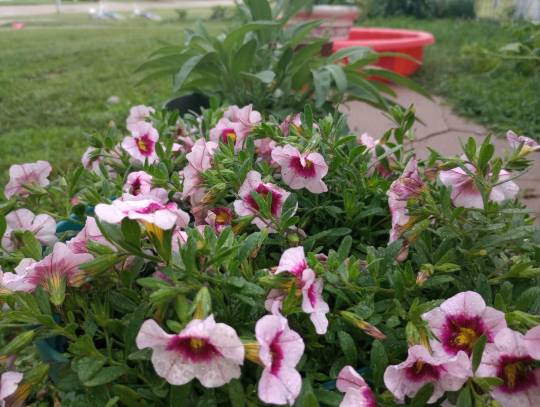
My dad's geriatric cat, Oddball, was having none of my shit. Two days ago he came up to where I was squatting and pulling grass, and he rubbed himself along my back and sprayed me. Joy. Some sage and thyme in my pots.

Sage in a pot in a plastic swimming pool, because.

Randomly growing mystery squash (probs pumpkin) that grew up in an unexpected location.
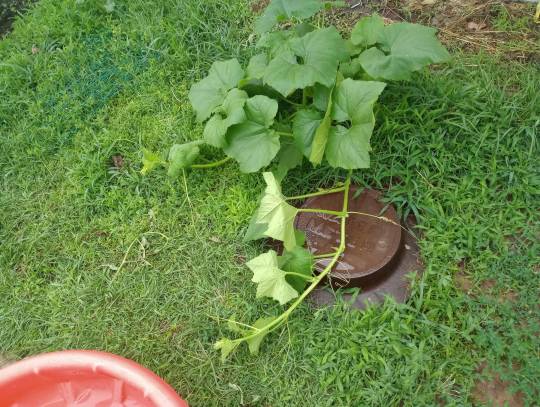
I had allocated all my planter space when Pops brought home a cherry tomato. It almost died before I found a spot. There are tiny nasturtiums from previous years growing up around it.

Hot peppers (Thai dragon and Armageddon variety) I'm growing for my nephew.

Behbeh Black-Eyed Susans I'm growing near my grandmother's antique trellises.

My strawberries, which I need to mow down immediately. They finally produced this year. If I want a good yield next year, I gotta cut this nonsense down.
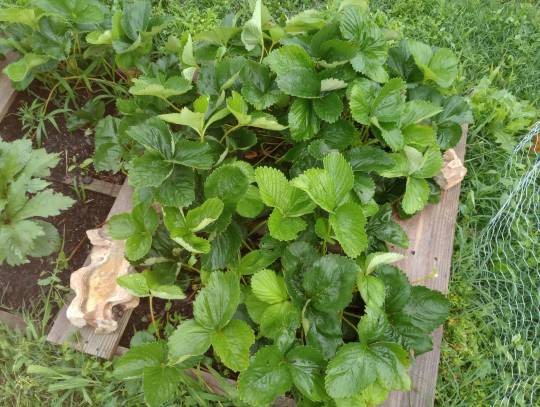
My beloved okra plants. SO DELICIOUS. I got the red okra variety this year.


Some type of sweet pepper, lol.
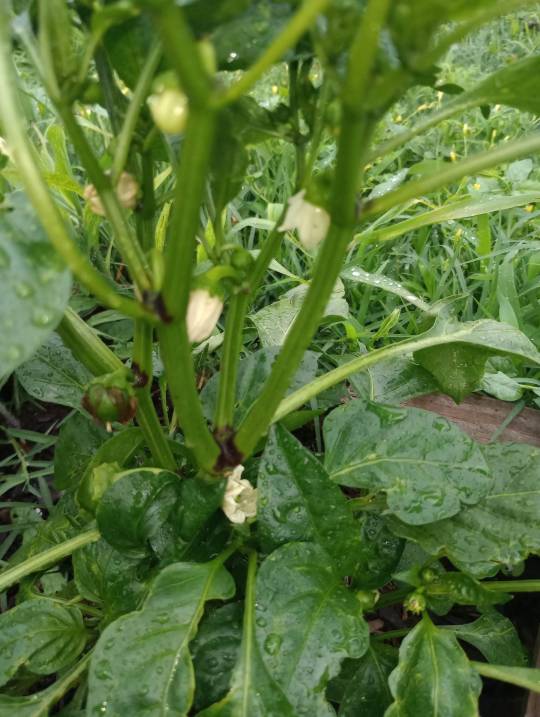
My tiny circle wildflower meadow. I have yarrow, echinacea (white and purple), Russian sage (I'm so proud of that little mother fucker), guara, hot lips sage, hollyhock, purple balloon flower, flying cardinal, black-eyed-susans, lamb's ear, milkweed, and amaranth, that I can yet identify. There are a couple mystery plants.


Rain-bedraggled wave-petunias.
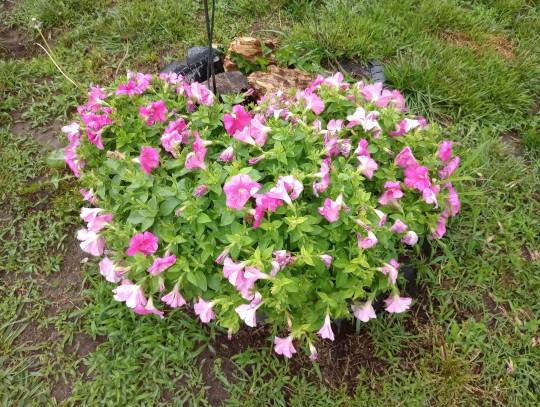
Tons of seeds dropped from our bird feeders. Probably sunflowers? Just letting them grow to see what happens.

Ever since Animal Crossing had a whole hydrangea themed thing on the mobile camp game a few years ago, I've been dying to get some. The ones I planted last year - my dear Papa mowed over them TWICE, successfully murdering them. These ones are SO gorgeous and I'm so happy and proud to have them.

Some clematis next to a trellis. I may never win yard of the month because it's about COMPLIANCE and not beauty, but I sure do have the most gorgeous fucking yard in the neighborhood.

My cat-toilet/shade garden. The fact that any of this is still alive is miraculous. Yes, my ex is buried under there.

If I were a herbivorous dinosaur, I would eat the FUCK out of hostas. More of my shade garden.

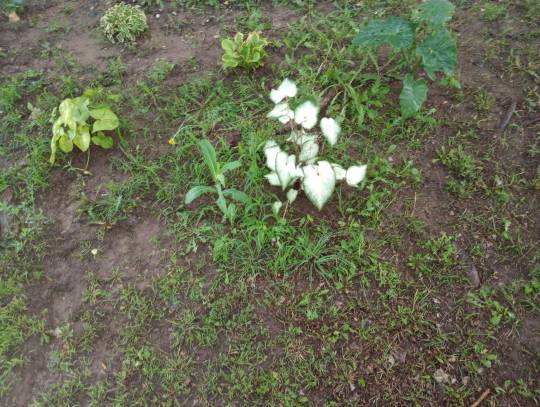
Some lysanthus.
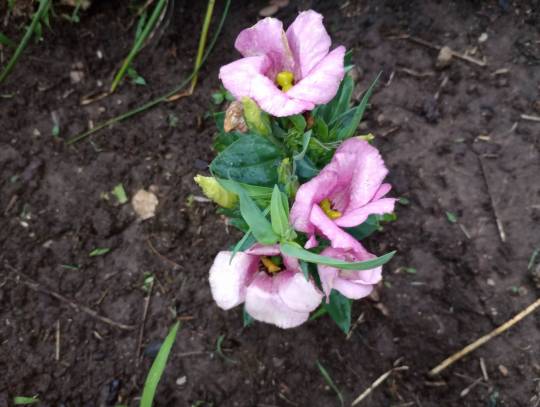
I have two other tomato plants, chives, and carnations as well. I have an orchid inside that is currently DYING because outdoor plants? Sure! I'm golden! Once those poor bastards go inside...
I hope you enjoyed this tour of my garden. Thank you, and good morning.
#the hobbit#lobelia#gardening#flowers#vegetable gardening#central plains#bread basket#kansas#lobelia sackville baggins
1 note
·
View note